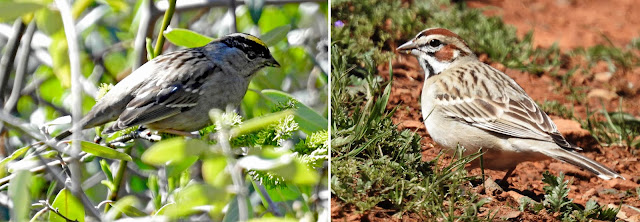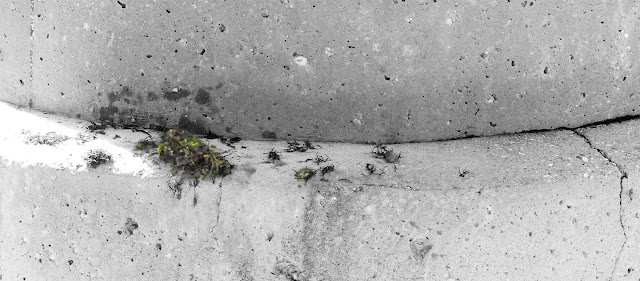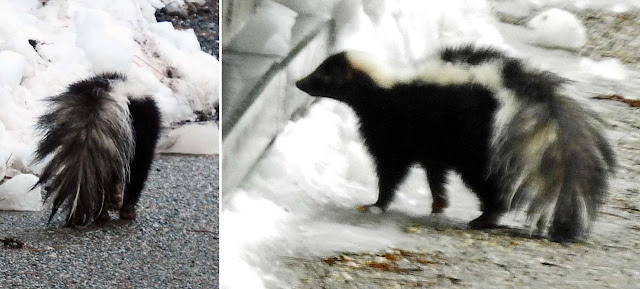American Dipper - Cinclus mexicanus
Dipper Watch!
I've gone down to watch the Dippers build their nest six times this week! I missed one day because it was snowing! It's been fascinating to watch their day-to-day progress! Every morning I'm surprised to see how much they've added to the nest since the previous morning! They must make hundreds of trips to collect moss for their nest! I limit my viewing time to a minute or so, because I don't want to disturb them.
Dipper Nest - Day One
The first time I saw them at their nest site, there was just a scattering of moss on the ledge. Later that day, the outline of the nest was covered in moss! Both of the Dippers collected moss for the nest.
The Cornell Lab of Ornithology states: "Pair formation happens in the winter for American Dippers. Both the male and female sing quite loudly in order to be heard by their mate or potential mate, over the sound of the rushing water! Although Dippers do not mate for life, they often mate with the same female several years in a row! Some males will mate with more than one female. A mated pair will defend their long linear "territory" on a river or stream, and keep intruders/competitors away from their nesting area. Both male and female build the nest, and care for the fledglings. Pairs will live together year-round if food and habitat are available."
Dipper Nest - Day Two
I didn't see the Dippers on Day Two, but they had obviously been busy recently, as the moss was dripping wet!
Cornell states: "Although spray (from river) not essential to nest-site selection, bird wets material in creek before putting it in nest; stands inside nest to construct sloping sides and roof, and weaves material into place. Nest construction commonly occurs during freezing temperatures."
Dipper Nest - Day Three
On Day Three the walls of the nest were starting to take shape! I loved how the Dippers worked together. One brought in the moss while the other arranged it and then "hammered" it into place! It was almost like watching little woodpeckers, the way they pecked at the moss inside the dome to wedge it together!
Cornell states: "Female forced “fresh wet material into interstices of already constructed and partially dry wall, from inside, as a shoemaker uses his awl...[She worked] from the bottom up...the walls raised on all sides by forcing the building material into the wall from below...(F)ibers on the outside...lie loose, plush-like, to lead the water from the dome roof as from a hay-cock. As this work on the walls dries, the insertion of other plugs...knits the whole densely...by working from below, the lips or edges of the walls from all sides are closed up...while working on the lower side the bird lay flat on the floor, spread her wings for a purchase and seemed to push with all her strength to insure a well-caulked seam.” - by Henderson, J. (1908). The American Dipper in Colorado.
Dipper Nest - Day Four
By Day Four the side walls were well established! It looked like maybe they had also started working on an "inner cup", but it was hard to tell. They spent most of their time inside the nest, adding moss and wedging it in!
Cornell states: "The outer shell of moss is made with small amounts of interwoven grass (both stems and roots) and leaves, (10" wide x 8" tall). There is also an inner chamber that is globular with woven cup or pad, to hold their eggs, composed of grass and leaves, sometimes bark (2" to 3" wide)."
Dipper Nest - Day Five
Dipper Nest - Day Six
On Day Six, I was startled at how much they had built up the nest in the last two days! Wow! They were still "hammering away " on the inside of the walls, one at a time. Both of the Dippers were still flying off and returning with moss.
Cornell states: "A Dipper nest is well-insulated; seems adapted to control inside temperature (warm or cool, as necessary) and to keep the inside dry. Thick outside mossy shell (3–5 cm thick) absorbs moisture; inside coarse grasses resist wetting."
Dipper Nest - Day Seven
On Day Seven it looked like they had completed the nest! I'm not sure if they're still going to work more on it or not. I'll just have to keep watching! So if it is done, it took just 7 days for the two of them to build this fabulous, double-walled, insulated, amazing, domed nest! WOW!!!
Here's a video of the Dippers at work! Enjoy!
Tufted Poppy - Lacepod - Popcorn Flower
Eschscholzia caespitosa - Thysanocarpus curvipes - Plagiobothrys nothofulvus
Springtime at South Yuba River State Park
The day before the snowstorm came in, I drove down to South Yuba River State Park to see how the wildflower bloom was progressing. It was almost in full bloom, with wildflowers covering the open slopes along the South Yuba River! Just enchanting! The river was an incredible translucent turquoise-green, and was high and fast from the recent rainfall!
South Yuba River - 3/27/23
I hiked in the park for several hours and took tons of photos! The day was mostly sunny, with a few puffy clouds in the blue sky. It felt great to be in a green, lush, blooming, springtime landscape! Here are some of the flowers I saw. Enjoy!
Bird's Eye Gilia - Zigzag Larkspur - Blue Dicks
Gilia tricolor - Delphinium patens - Dichelostemma capitatum
Tufted Poppy - Lacepod
Eschscholzia caespitosa - Thysanocarpus curvipes
Lacepod - Popcorn Flower - Caterpillar Phacelia
Thysanocarpus curvipes - Plagiobothrys nothofulvus - Phacelia cicutaria
Common Fiddleneck - Amsinckia menziesii
Purple Sanicle - Red Maids - Pacific Sanicle
Sanicle crassicaulis - Calandrinia menziesii - Sanicle bipinnatifida
Sky Lupine - Popcorn Flower - Tufted Poppy
Lupine nanus - Plagiobothrys nothofulvus - Eschscholzia caespitosa
Blue Oak and spring grasses - Quercus douglasii
In another part of the park, I hiked up a hill covered in new green grasses and a forest of Blue Oak and Gray Pine. The Blue Oaks were just starting to leaf out! It was a glorious day in the foothills. I'll be back again soon!
Blue Oak Woodland - Quercus douglasii
Daugherty Hill Wildlife Area
Two days before the snowstorm came in, my husband and I drove down to Daugherty Hill for a hike in the foothills. This preserve is a little higher than South Yuba State Park, and is barely starting to bloom. However, it is lush and green and the trees are covered in tiny new leaves! It was gorgeous!
Golden-crowned Sparrow - Lark Sparrow
Zonotrichia atricapilla - Chondestes grammacus
We saw a small flock of Golden-crowned Sparrows feeding in the willows. They are probably on their way north to their breeding ground in Alaska!
We also saw one Lark Sparrow feeding on the trail! The Lark Sparrows will probaby nest here. They build their nests on bare ground, or slightly above ground in a shrub, in habitats like Table Mountain. Right now is their breeding season, and males are known to give a female a twig during copulation, which she then flies off with and places in her nest! 3-6 eggs are laid per clutch, and hatch within 12 days! Both male and female adults feed the nestlings, which can fly within 9 days! I love the markings and colors of the adults! Beautiful!
Acorn Woodpeckers - American Robin
Melanerpes formicivorus - Turdus migratorius
Acorn Woodpeckers live here year-round. The American Robin might stay here all year as well! Both of them were making lots of calls and chasing potential mates through the Blue Oak Woodlands!
Black-tailed Jackrabbit - Lepus californicus
We saw two Black-tailed Jackrabbits while we were hiking, but they were too fast for photos. Sure would like to really watch one of these sometime!
Britannica.com states: "Jackrabbits rarely walk, but hop 5'-10' at a time. When panicked they can hop up to 20' at a time, and can travel at 30-35 mph! They are preyed on by coyotes, bobcats, foxes, hawks, owls and snakes. They are mostly active from dusk to dawn. The female black-tailed jackrabbit can have as many as four litters a year. The young are born in a fur-filled depression, or form. Most litters have 3-4 young. The mother will separate the young and put them in individual forms, to help reduce the chance of predation. They will nurse for only the first 3-4 days of their life. During the remainder of their lives, they eat green plants in the spring and summer, and woody, dry vegetation in the winter."
Blue Oaks and springtime shadows - Quercus douglasii
It was another beautiful day down in the foothills! We'll be back in a week or so to see what's blossomed!
What new birds are going to arrive?
Have the willows blossomed?
Check back next week for the answers to these questions and more!
Unfortunately, you can no longer sign up to get my blog via email. Just go to northyubanaturalist.blogspot.com directly.
Your questions and comments are greatly appreciated. Please feel free to email me at northyubanaturalist@gmail.com. Thanks!























.jpg)







.jpg)
.jpg)




.jpg)



















